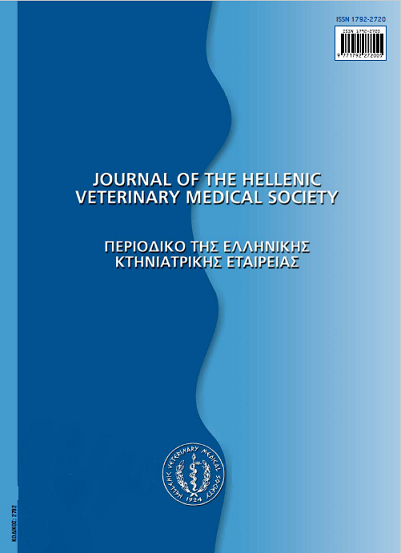Sheeppox in Evros. A 7-year (1994 - 2000) retrospective study
Abstract
Sheeppox is a highly transmissible disease that caused the development of serious economical losses to the livestock of Evros County. From 1994 to 2000, following an absence of appearance in 1999, sheeppox has constantly occurred on a year basis. During the last sheepox epidemic in 1998, eradication measures have been implemented to control the disease. Stamping out of the animals from affected flocks and flock vaccination for the risk areas have been performed. Since 1994 and after, elimination procedures have been applied on affected and suspected flocks. In particular, (83), (677), (21.020), (8.838), (1512) and (507)animals were eliminated (stamping out) in 1994, 1995, 1996, 1997,1998 and 2000 respectively. The mode of transmission of pox disease must be differentiated from the Foot and Mouth disease and its expected incidence during an outbreak period. The compulsory by legislation 21-day isolation of pox-infected flocks shall be considered insufficient due to the virus resistance. Pox nodules, primarily seen on the parts of the body not covered by wool and skin lesions on the tail, are the most typical clinical signs. There is evidence to believe that pox virus was introduced into Greece from Turkey, because the disease is endemic in Turkey and our primary incursions have been detected close to Evros River, the borderline between the two countries. Area of epidemiological importance, where new outbreaks have yearly occurred (no reports in 1994), is Orestiada landscape, including Petrades village. The first confirmed cases of sheeppox, which were reported in fall 1994-95, 2000 (October- November) and summer 1996-98 (July). No cases were reported in winter. In this study, the sheep pox statistics, epizootiology, symptomatology, control measures and photo-images of the disease were reviewed based on cumulative experience.
Article Details
- How to Cite
-
DADOUSIS (Κ. ΔΑΔΟΥΣΗΣ) C. (2018). Sheeppox in Evros. A 7-year (1994 - 2000) retrospective study. Journal of the Hellenic Veterinary Medical Society, 54(2), 172–180. https://doi.org/10.12681/jhvms.15256
- Issue
- Vol. 54 No. 2 (2003)
- Section
- Review Articles
Authors who publish with this journal agree to the following terms:
· Authors retain copyright and grant the journal right of first publication with the work simultaneously licensed under a Creative Commons Attribution Non-Commercial License that allows others to share the work with an acknowledgement of the work's authorship and initial publication in this journal.
· Authors are able to enter into separate, additional contractual arrangements for the non-exclusive distribution of the journal's published version of the work (e.g. post it to an institutional repository or publish it in a book), with an acknowledgement of its initial publication in this journal.
· Authors are permitted and encouraged to post their work online (preferably in institutional repositories or on their website) prior to and during the submission process, as it can lead to productive exchanges, as well as earlier and greater citation of published work.



